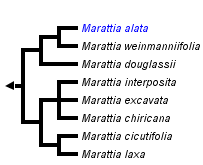Marattia
Maarten Christenhusz


This tree diagram shows the relationships between several groups of organisms.
The root of the current tree connects the organisms featured in this tree to their containing group and the rest of the Tree of Life. The basal branching point in the tree represents the ancestor of the other groups in the tree. This ancestor diversified over time into several descendent subgroups, which are represented as internal nodes and terminal taxa to the right.

You can click on the root to travel down the Tree of Life all the way to the root of all Life, and you can click on the names of descendent subgroups to travel up the Tree of Life all the way to individual species.
For more information on ToL tree formatting, please see Interpreting the Tree or Classification. To learn more about phylogenetic trees, please visit our Phylogenetic Biology pages.
close boxIntroduction
Marattia is a mostly neotropical genus of eight species, but one species (M. douglassii) occurs on Hawaii. They usually occur in mountainous areas above 900 m elevations, but they may occur at lower elevation on islands.
Murdock (2008) showed that Marattia in its traditional sense is widely polyphyletic. The name can only be kept in its traditional sense if all Angiopteris and Christensenia would be merged into Marattia, leaving the family with just 2 genera (Marattia and Danaea). This scenario is very unwarranted, because Angiopteris is a morphologically well-established genus and differs from Marattia in many obvious characters. To retain Angiopteris and Christensenia, Marattia was therefore segregated into three genera Eupodium, Ptisana and Marattia. The true Marattia occur in the Neotropics and Hawaii, Eupodium is only Neotropical and all the old world species are transferred into the new genus Ptisana.
Characteristics
Marattia is recognized by sessile, bivalved synangia. The fronds are usually twice or more pinnate, and usually triangular in shape. The ultimate pinnules are generally alternately arranged, but the pinnae are often opposed, especially in 3-pinnate species with deltate blades. Their rhizomes are radially arranged and usually globular, with the stipules opened.
References
Christenhusz, M. J. M. (2007). Evolutionary History and Taxnomy of Neotropical Marattioid Ferns: Studies of an ancient lineage of plants. Annales Universitatis Turkuensis ser. AII, tom. 216, pp. 1-134.
Lavalle, M. C. (2003). Taxonomía de las especies neotropicales de Marattia (Marattiaceae). Darwiniana 41, pp. 61-86.
Murdock, A. (2008). A taxonomic revision of the eusporangiate fern family Marattiaceae, with description of a new genus Ptisana. Taxon 57, 737-755.
Information on the Internet
- Botany Photos: Marattiaceae. Plant Images by Maarten Christenhusz.
About This Page
Maarten Christenhusz

The Natural History Museum, London, United Kingdom
Correspondence regarding this page should be directed to Maarten Christenhusz at
Page copyright © 2009 Maarten Christenhusz
 Page: Tree of Life
Marattia.
Authored by
Maarten Christenhusz.
The TEXT of this page is licensed under the
Creative Commons Attribution-NonCommercial License - Version 3.0. Note that images and other media
featured on this page are each governed by their own license, and they may or may not be available
for reuse. Click on an image or a media link to access the media data window, which provides the
relevant licensing information. For the general terms and conditions of ToL material reuse and
redistribution, please see the Tree of Life Copyright
Policies.
Page: Tree of Life
Marattia.
Authored by
Maarten Christenhusz.
The TEXT of this page is licensed under the
Creative Commons Attribution-NonCommercial License - Version 3.0. Note that images and other media
featured on this page are each governed by their own license, and they may or may not be available
for reuse. Click on an image or a media link to access the media data window, which provides the
relevant licensing information. For the general terms and conditions of ToL material reuse and
redistribution, please see the Tree of Life Copyright
Policies.
- First online 23 January 2009
- Content changed 23 January 2009
Citing this page:
Christenhusz, Maarten. 2009. Marattia. Version 23 January 2009 (under construction). http://tolweb.org/Marattia/134240/2009.01.23 in The Tree of Life Web Project, http://tolweb.org/





 Go to quick links
Go to quick search
Go to navigation for this section of the ToL site
Go to detailed links for the ToL site
Go to quick links
Go to quick search
Go to navigation for this section of the ToL site
Go to detailed links for the ToL site